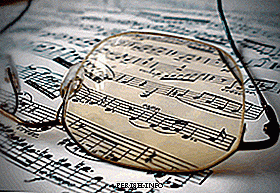 To know how to determine the tonality of a work, it is required, first of all, to understand the concept of "tonality". You are already familiar with this term, so just to remind you, without delving into the theory.
To know how to determine the tonality of a work, it is required, first of all, to understand the concept of "tonality". You are already familiar with this term, so just to remind you, without delving into the theory.
Tonality - in general, is the pitch of the sound, in this case, the pitch of the sound of a fret - for example, major or minor. Lad - this is the construction of the scale according to a certain pattern and, moreover, the fret is a specific sound coloring of the scale (the major fret is associated with light tones, the minor - with sad notes, shadow).
The height of each particular depends on its tonic (the main stable note). That is a tonic - this is the note to which the harness is attached. Lad in interaction with the tonic and gives the tonality - that is, a set of sounds arranged in a certain order, located at a specific pitch.
How to determine the tone of the work by ear?
It is important to understand that not at any moment of sound You can accurately say what tone this part of the piece sounds like. Need to select individual moments and analyze them. What are these moments? This may be the very beginning or the very end of the work, as well as the end of a section of the work or even a single phrase. Why? Because the beginnings and the ends sound steadily, they assert the tonality, and in the middle they usually move away from the main tonality.
So, choosing a fragment for yourself notice two things:
- what is the general mood in the work, what mood - major or minor?
- which sound is the most stable, which sound is suitable for completing the piece?
When you determine this, a clearing should happen to you. It depends on the type of mood - whether it is a major key or a minor key, that is, what is the key of the key. Well, tonic, that is, a steady sound that you heard, you can simply pick up on the instrument. So, you know tonic and well-known mood. What else is needed? Nothing, just connect them together. For example, if you heard a minor mood and tonic fa, then the tonality will be - in F minor.

How to determine the tone of the work in the notes?
But how to determine the tonality of the work, if you have notes on your hands? You probably already guessed that you should pay attention to the signs at the key. In most cases, these signs and tonic can accurately determine the tonality, because the key signs put you in front of the fact, offering only two specific tones: one major and one parallel minor. What kind of tonality in this work depends on the tonic. More information about the key signs can be found here.
Finding tonic can be difficult. Often this is the last note of a piece of music or its logically completed phrase, a bit less often it is also the first. If, for example, a work begins with an overrun (an incomplete beat preceding the first one), then often the stable note is not the first, but the one that comes from the strong fraction of the first normal full beat.
Do not be lazy to look at the part of the accompaniment, according to it you can guess which note is a tonic. Very often the accompaniment beats the tonic triad, which, as the name implies, contains tonic, and, by the way, the mood also. The final accompaniment chord almost always contains it.
Summarizing the above, we highlight a few steps that you must take if you want to determine the tone of the work:
- At the hearing - to find out the general mood of the work (major or minor).
- Having notes in your hands - look for alterations signs (at the key or random in places where the tonality changes).
- Determine the tonic - conditionally this is the first or last sound of a melody, if it is not suitable - determine a stable, "supporting" note by ear.
It is hearing that is your main tool in solving the issue to which this article is devoted. By following these simple rules, you will be able to determine the tone of a piece of music quickly and correctly, later you will learn to identify tonality at a glance. Good luck!
By the way, a good clue for you at the initial stage can be a cheat sheet known to all musicians - the fifth quint circle of major keys. Try to use it - very convenient.

Leave Your Comment